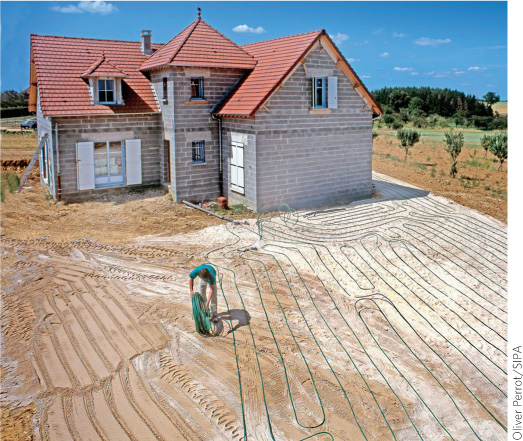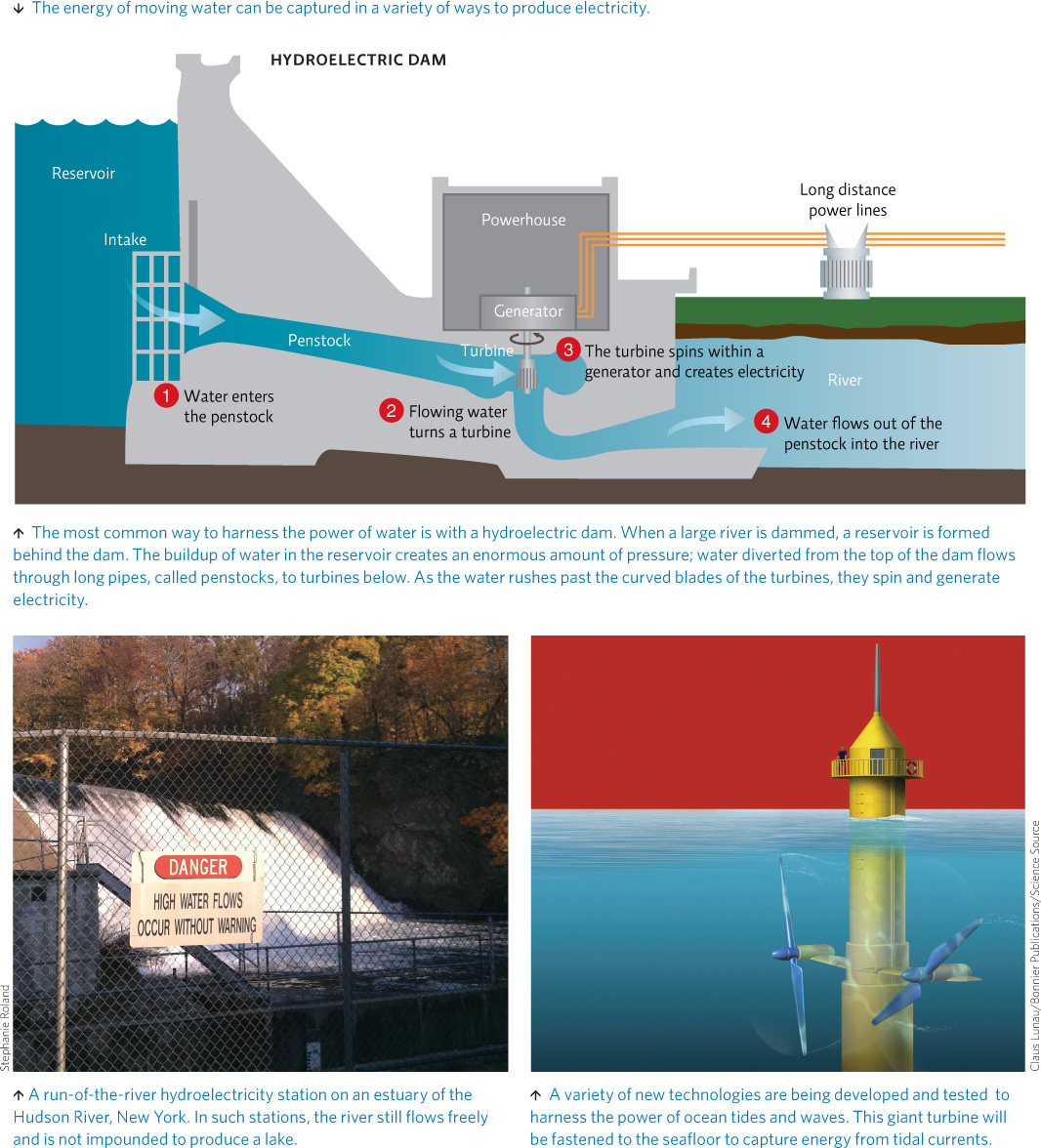The power of water can be harnessed but comes with trade-offs.
KEY CONCEPT 23.6
Water power can be harnessed to generate electricity. Large dams are the most common and productive method, but there are other, less destructive technologies in use and development.
The island of Samsø is shaped curiously like a violin. It is also surrounded by one of the most significant sources of renewable energy worldwide: water.
Humans have harnessed the power of falling water for thousands of years, ever since early civilizations used watermills to grind grain into flour. Today, energy produced from moving water— known as hydropower— supplies more electricity to the population than any other single renewable resource. Approximately 7% of electricity used in the United States and 28% around the world is generated from hydropower. Large-scale hydroelectric power plants at giant dams are the source of most of that power.
hydropower
Energy produced from moving water.
Like wind energy, hydropower is an indirect form of solar energy. The downward flow of water from mountaintop to ocean is a consequence of the water cycle, a process of evaporation and condensation driven by the Sun’s heat. (See Chapter 14 for more information about the water cycle.) Hydropower is abundant, clean, and does not typically produce greenhouse gases.
There are a variety of ways to harness the energy of moving water—from ocean waves and the tides to capturing energy released from variations in ocean temperatures (ocean thermal energy conversion)—but the most common way to generate hydropower is with dams. The Grand Coulee Dam on the Columbia River in Washington State is one of the largest concrete structures on the planet and the third-largest dam. The 12 million cubic yards of concrete that make up the dam could form a 1.2-meter-wide (4-foot-wide) sidewalk wrapped twice around the equator. The dam is the largest electrical power producer in the United States, with a total generating capacity of 6,809 MW. The reservoir created by the dam, an artificial lake that pools behind the structure (called an impoundment), stretches some 240 kilometers (150 miles) to the Canadian border. Three power plants at the Grand Coulee Dam contain 24 generators, which produce enough electricity to power two cities the size of Seattle.


461
But hydropower from large dams is far from an ideal resource. It wasn’t a real option on Samsø, for instance, because the island lacks high mountain peaks whose runoff would feed large rivers. So geography is a key factor. Importantly, hydroelectric systems also come with some significant drawbacks. Electricity generation capacity can vary from year to year based on rainfall amounts. Also, dams that restrict water flow can curtail water supplies to downstream areas. Further, in hot climates, huge amounts of water evaporate from reservoirs. But more significantly, dams are responsible for the loss of major habitats and the displacement of tens of millions of people around the globe. It is the most debated and contentious of any renewable energy resource.
This is nowhere more apparent than at the Grand Coulee. “The Grand Coulee has had a huge impact for good and for ill,” says Michael Garrity, Washington Conservation Director for American Rivers, an organization dedicated to protecting America’s rivers. As the final loads of concrete were placed and the first generator at Grand Coulee was switched on in 1941, crowds gathered on the hill above the dam to marvel at the “birth of one of the world’s greatest waterfalls,” a local paper proclaimed. But nearby, thousands of Native Americans watched in horror as habitats, homes, and livelihoods were irreversibly lost under the pool of water engulfing the land behind the dam.
For nearby Native American communities, the Grand Coulee was a humanmade disaster that sacrificed not only land but a staple of their economy and culture—salmon. Salmon are migratory fish: They hatch in the freshwater tributaries of the Columbia, migrate downstream into the Pacific Ocean to spend most of their lives in salt water, then return to the freshwater environment of their origin to spawn. But the Grand Coulee Dam blocked the way; salmon and trout runs upstream of the dam were completely wiped out.
Not all hydropower systems have the same impact as a giant dam. A run-of-the-river hydroelectric system, often a low stone or concrete wall, doesn’t block the water; it merely directs some of the flowing water past a turbine and thus generates electricity from the natural flow and elevation drop of a river, which is less disruptive to the river ecosystem. But energy production is dependent on the flow of a river at any particular time, so such a system is suitable only for rivers with dependable flow rates year-round. Such systems are useful in remote areas where electricity can be costly, and they are good candidates to supplement solar power systems, since annual periods of high sunlight often have low water flow and vice versa. INFOGRAPHIC 23.5
HARNESSING THE POWER OF WATER


Do you feel the energy production and recreational/flood control benefits of large hydroelectric dams outweigh the permanent ecological and community destruction they cause? Explain your position.
Answers will vary but should be supported.
Garrity and other conservation groups still hope that new technologies will someday make existing dams like the Grand Coulee more eco-friendly. “We are advocates for harnessing resources from our rivers,” he says, “but in a way that’s sustainable.”